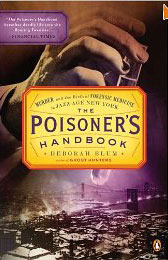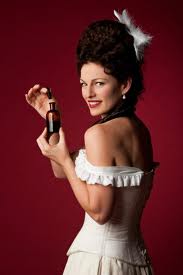The Poisoner’s Handbook: Murder and the Birth of Forensic Medicine
Source: amazon.com
 These days, as I travel the country talking about The Poisoner’s Handbook, I’m frequently asked that question or variations on it. What’s your favorite poison? What’s the perfect poison? The answer to the latter is that it doesn’t exist--except in the plots of crime novels.
These days, as I travel the country talking about The Poisoner’s Handbook, I’m frequently asked that question or variations on it. What’s your favorite poison? What’s the perfect poison? The answer to the latter is that it doesn’t exist--except in the plots of crime novels.But in reality, poisons really are fascinatingly wicked chemical compounds and many of them have fascinating histories as well. Just between us, then, here’s a list of my personal favorites.
1. Carbon Monoxide (really)--It’s so beautifully simple (just two atoms--one of carbon, one of oxygen) and so amazingly efficient a killer. There’s a story I tell in the book about a murder syndicate trying to kill an amazingly resilient victim. They try everything from serving him poison alcohol to running over him with a car. But in the end, it’s carbon monoxide that does him in.
2. Arsenic--This used to be the murderer’s poison of poisons, so commonly used in the early 19th century that it was nicknamed “the inheritance powder”. It’s also the first poison that forensic scientists really figured out how to detect in a corpse. And it stays in the body for centuries, which is why we keep digging up historic figures like Napoleon or U.S. President Zachary Taylor to check their remains for poison.
3. Radium--I love the fact that this rare radioactive element used to be considered good for your health. It was mixed into medicines, face creams, health drinks in the 1920s. People thought of it like a tiny glowing sun that would give them its power. Boy, were they wrong. The two scientists in my book, Charles Norris and Alexander Gettler, proved in 1928 that the bones of people exposed to radium became radioactive--and stayed that way for years.
4. Nicotine--This was the first plant poison that scientists learned to detect in a human body. Just an incredible case in which a French aristocrat and her husband decided to kill her brother for money. They actually stewed up tobacco leaves in a barn to brew a nicotine potion. And their amateur chemical experiments inspired a very determined professional chemist to hunt them down.
5. Chloroform--Developed for surgical anesthesia in the 19th century, this rapidly became a favorite tool of home invasion robbers. If you read newspapers around the turn of the 20th century, they’re full of accounts of people who answered a knock on the door, only to be knocked out by a chloroform soaked rag. One woman woke up to find her hair shaved off--undoubtedly sold for the lucrative wig trade.
6. Mercury--In its pure state, mercury appears as a bright silver liquid, which scatters into shiny droplets when touched. No wonder it’s nicknamed quicksilver. People used to drink it as a medicine more than 100 years ago. No, they didn’t drop dead. Those silvery balls just slid right through them. Mercury is much more poisonous if it’s mixed with other chemicals and can be absorbed by the body directly. That’s why methylmercury in fish turns out to be so risky a contaminant.
7. Cyanide--One of the most famous of the homicidal poisons and--in my opinion--not a particularly good choice. Yes, it’s amazingly lethal--a teaspoon of the pure stuff can kill in a few minutes. But it’s a violent and obvious death. In early March, in fact, an Ohio doctor was convicted of murder for putting cyanide in his wife’s vitamin supplements.
8. Aconite--A heart-stoppingly deadly natural poison. It forms in ornamental plants that include the blue-flowering monkshood. The ancient Greeks called it “the queen of poisons” and considered it so evil that they believed that it derived from the saliva of Cerberus, the three-headed dog guarding the gates of hell.
 9. Silver--Swallowing silver nitrate probably won’t kill you but if you do it long enough it will turn you blue. One of my favorite stories (involving a silver bullet) concerns the Famous Blue Man of Barnum and Bailey’s Circus who was analyzed by one of the heroes of my book, Alexander Gettler.
9. Silver--Swallowing silver nitrate probably won’t kill you but if you do it long enough it will turn you blue. One of my favorite stories (involving a silver bullet) concerns the Famous Blue Man of Barnum and Bailey’s Circus who was analyzed by one of the heroes of my book, Alexander Gettler.10. Thallium--Agatha Christie put this poison at the heart of one of her creepiest mysteries, The Pale Horse, and I looked at it terms of a murdered family in real life. An element discovered in the 19th century, it’s a perfect homicidal poison--tasteless and odorless--except for one obvious giveaway--the victim’s hair falls out as a result of the poisoning!
Now that I’ve written this list, I realize I could probably name ten more. But I don’t want to scare you.
Article from: amazon.com
Deborah Blum is a Pulitzer-Prize winning science writer and the author of five books, most recently the best-seller, The Poisoner’s Handbook: Murder and the Birth of Forensic Medicine in Jazz Age New York. She writes for a range of publications including Time, Scientific American, Slate, The Wall Street Journal, The Los Angeles Times (and even the literary journal, Tin House). She is currently working on a sixth book about poisonous food.
Ten Clues to the Modern Poisoner
By Deborah Blum | Wired.com
[...]Contrary to what many people think, except in political killings, poisoners don’t make much use of exotic new compounds. They use – as they always have -what’s at hand. They kill for the same old reasons - for anger, jealousy possessiveness, greed. They are rare, as this analysis shows, far more rare than other forms of killing. And that’s probably the most important change. Poison homicides don’t occur as often as they did a hundred years ago, mostly because scientists are better at solving these mysteries.
But if you’re the kind of person who likes to be prepared against all possible harm, then I’ve put together this short list of warning signs based on a scatter of recent cases. Don’t take them too seriously, as I said, this kind of thing is rare. But still, there’s a few reasonable assumptions here. For instance, you should probably pay attention if:
1. Your bowl of Rice Krispies tastes like solvent.
In January, a southern California man poured the paint remover, Goof Off, into his wife’s evening cereal snack. After swallowing a spoonful, she turned to her daughter saying “Something’s in it. Something’s in it.” Her daughter called 911. When police came to the hospital, the husband fled the building (he was arrested later at a nearby convenience store). He pleaded guilty in March and was sentenced to eight years in prison.
2. The coffee in your morning cup turns green.
In March a Kentucky man was charged with poisoning his estranged wife’s coffee. She called the police after she noticed the dark liquid in her cup had an oily greenish tint. A lab analysis found a sludge of rat poison in the bottom of the pot. He told the police that he was merely trying to make her a little sick. But she said friends had warned her that he planned to kill her after she started divorce proceedings.
3. Your coffee is, maybe, a little too bitter.
In 2010, a Long Island man pleaded guilty to killing his wife by putting cyanide in her coffee. The couple, who had two sons, had separated after he told her that he’d realized that he was gay. But he later told police he’d also realized that he didn’t want her to be with anyone else.
4. Your iced tea is, maybe, a little too sweet.
In July, police brought murder charges against a Cleveland, Ohio woman, accusing her of poisoning her fiance with antifreeze in 2006. Although evidence of ethylene glycol – the key ingredient in antifreeze – was found early in the investigation, it took police years longer to build a conclusive case for the poisoning itself. Detectives said ethylene glycol, which is known both for its strong, sweet taste and ability to destroy the kidneys, was mixed into the victim’s iced tea. She was ready, they said, for the relationship to be over.
5. Your mother mixes you up a cocktail when she has never done so before.
One of the more notorious recent poison killers, Stacy Castor of Clay, New York, was convicted of murder in 2007 for killing her husband with antifreeze. She then tried to frame her daughter for the crime, writing a fake suicidal confession, and serving the girlan unexpected cocktail of orange juice, soda, and crushed painkillers. The girl told police that the drink tasted “nasty” but she swallowed at her mother’s urging. Her survival led to a break in the case.
[...]
Read the full article at: wired.com






















